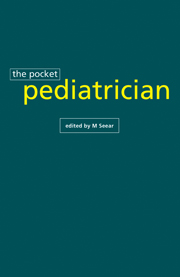Book contents
- Frontmatter
- Contents
- Analytical contents list
- Preface
- 1 Cardiology
- 2 Death and dying
- 3 Emergencies
- 4 Endocrinology
- 5 Fluids and electrolytes
- 6 Gastroenterology
- 7 General surgery
- 8 Health care ethics
- 9 Hematology
- 10 Infectious diseases
- 11 Intensive care and continuous infusion drugs
- 12 Medical genetics
- 13 Neonatology and neonatal drug dosage guidelines
- 14 Neurology
- 15 Nutrition
- 16 Oncology
- 17 Pediatric transport
- 18 Pharmacology and drug dosage guidelines
- 19 Renal
- 20 Resident fellow training
- 21 Respirology
- 22 Rheumatology
- 23 Transfusion medicine
- 24 Appendix
- Index
23 - Transfusion medicine
Published online by Cambridge University Press: 01 February 2010
- Frontmatter
- Contents
- Analytical contents list
- Preface
- 1 Cardiology
- 2 Death and dying
- 3 Emergencies
- 4 Endocrinology
- 5 Fluids and electrolytes
- 6 Gastroenterology
- 7 General surgery
- 8 Health care ethics
- 9 Hematology
- 10 Infectious diseases
- 11 Intensive care and continuous infusion drugs
- 12 Medical genetics
- 13 Neonatology and neonatal drug dosage guidelines
- 14 Neurology
- 15 Nutrition
- 16 Oncology
- 17 Pediatric transport
- 18 Pharmacology and drug dosage guidelines
- 19 Renal
- 20 Resident fellow training
- 21 Respirology
- 22 Rheumatology
- 23 Transfusion medicine
- 24 Appendix
- Index
Summary
Blood products are potentially the most dangerous “pharmaceutical” that most physicians will ever prescribe. Transfusions can result in serious injury or death very soon after transfusion, within weeks or months of transfusion, or many years after the date of transfusion. In general, physicians have not approached transfusion with this type of philosophy and, in part, the tragedy of transfusion transmitted infection is a consequence of inappropriate transfusion practice. In the current climate, each transfusion episode should be approached very carefully and the benefits and possible complications of a transfusion carefully weighed in an individual clinical situation. The risks must be carefully explained to the patient or family. These stipulations apply to elective and nonurgent transfusions, but even in urgent clinical situations, the use of blood products should always be preceded by careful thought.
BLOOD PRODUCT COLLECTION, PREPARATION AND TESTING
Blood donors should be healthy adults. For first time donors, the age limits are 17 to 60 years; for established donors the upper age limit is 71 years. Donors are required to complete a questionnaire and undergo a face–to–face interview regarding their physical well being and past medical history and behavior. In most centers, donors are also required to complete a confidential exclusion or self–designation form. This form allows those donors who may in the past have engaged in high risk sexual and other activities to exclude themselves from the donor pool and ensures that their blood is used for research purposes only. Using strict asepsis, the donations are collected from an antecubital vein into sealed plastic packs.
- Type
- Chapter
- Information
- The Pocket PediatricianThe BC Children's Hospital Manual, pp. 560 - 570Publisher: Cambridge University PressPrint publication year: 1996



